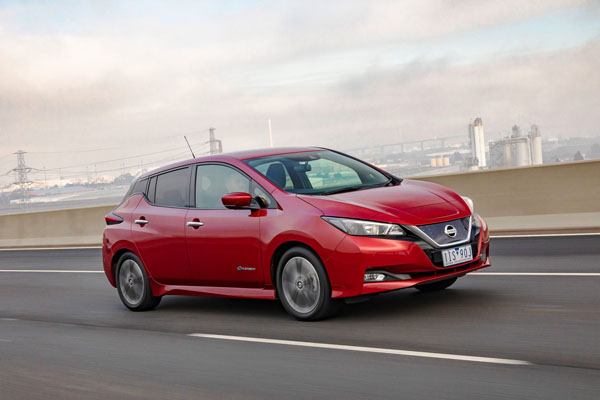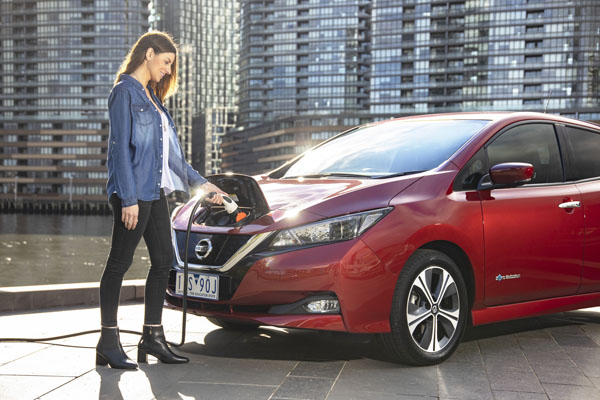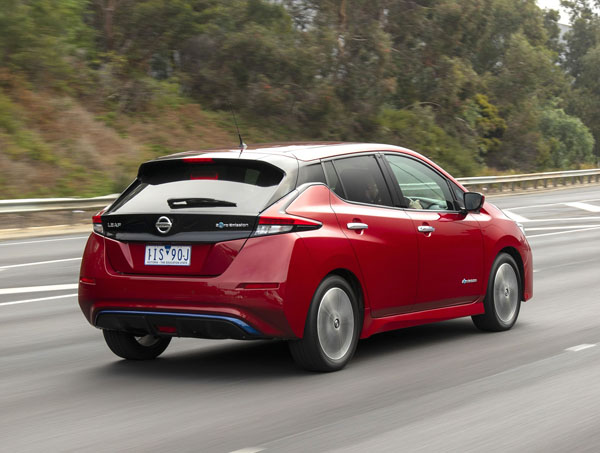
Turning over a new Leaf. Is there an end to the number of times Nissan can add to its all-electric compact vehicle? First it was the ability to run household electrical goods from the car’s battery.
In July the company’s pioneering vehicle-to-grid technology arrived in Australia with a government trial set to deliver power back to the grid through the car’s bi-directional charging capability.
Now in a world first, drivers can pay for parking while visiting Nissan Pavilion exhibition space in Yokohama with power from their Leaf battery. However, I digress.
Powered by its 40 kWh 350V battery, the test was not without some range anxiety of going the distance.
The battery can be charged from a standard household power point in about 24 hours, or from empty-warning-to-80 per cent in 60 minutes.
Leaf can be charged at any of the 783 public stations around Australia. However only 69 are of the quick charge variety. Queensland’s government, for example, has installed a string of 18 DC chargers all the way from Coolangatta to Cairns.
At $49,990, plus on road costs, the new Nissan Leaf is not cheap to buy. Then there is the option of having a fast charging unit fitted at home. This can add up to more than $1500, depending on the unit.
 STYLING
STYLING
Nissan’s aim was clean and simple lines and a sleek silhouette. The maker’s V-motion “radiator” grille, boomerang light set-up and floating roof raise no doubts about the car’s origin.
While on the outside the Leaf looks like a conventional petrol powered hatchback. It does proudly shows off its EV badging and ‘zero emission’ tag, the latter on both flanks.
Dusk sensing LEDs with dual, direct-lens low and high beams, enhancing illumination ahead, are a first for Nissan. Aerodynamic body features and wheels gives the Leaf a drag co-efficient of Cd 0.28.
INTERIOR
Inside the cabin the word was premium ambience with room to relax. A sporty flat-bottom, leather wrapped heated steering wheel incorporates multi-functions. These include Advanced Drive-Assist, which can be used by the driver without their taking hands off the wheel.
A redesigned centre console with cup holders between driver and front passenger seats includes a new storage area at its base ideal for phone or wallet, as well as easily reached power switch, 12V outlet and USB port.
The rear cargo area of 405 litres (seatbacks up), 1176 litres (seatbacks down) has been redesigned to offer better use of space. Body and dimensions have not changed from the previous model, leaving room for four occupants in comfort, five without too much of a squeeze.
INFOTAINMENT
The combination of analogue speedo and multi-information display uses a 7-inch advanced Drive Assist display on the left incorporating a power meter.
The centre display screen allows the driver to operate audio and navigation systems and connect to smartphones. An 8-inch colour touchscreen allows Apple CarPlay and Android Auto to be operated.
ENGINES / TRANSMISSIONS
The new e-powertrain produces 110 kW of power, 38 per cent more than the previous model and 320 Nm of torque, 14 per cent up on the first-generation unit.
SAFETY
New Nissan Leaf has the five-star ANCAP rating. It has predictive forward collision warning, intelligent emergency braking, intelligent lane intervention, around view monitor with moving object detection, intelligent cruise control, rear cross-traffic alert, intelligent driver alertness, high beam assist and blind spot warning.
Add to this, vehicle dynamic control with traction control, front and rear parking sensors, front, front-side and side curtain airbags.
Because EVs are quieter than most cars, the Leaf has system that tells pedestrians who don’t look both ways before crossing the road that a Leaf is coming.
DRIVING
Unruffled is the perfect description of the Leaf’s performance. To match the improved output of the electric motor and converter, engineers enhanced the car’s chassis to improve stability.
Electric power steering now has a more linear feel and is more responsive. Noise, vibration and harshness have been moderated with aerodynamic upgrades and structural rigidity, while the electric motor has been made quieter, despite generating more power and torque.
Normal driving conventions of an automatic transmission apply to the Leaf, with the added advantage of 100 per cent torque on tap from the word go. And, boy, does the Leaf go, so much so the test car raised a few eyebrows from other road users in sports cars relying on petrol power to make a spirited performance stand.
Leaf has what is called an e-Pedal, which at the flick of a switch on the centre console, allows the vehicle to be driven using the accelerator alone. The car comes to a smooth, gradual halt and is held stationary without the use of the brake pedal.
Braking comes into its own with regeneration of electricity being fed back into the battery. On a 32 km mostly downhill run in the mountains of the Gold Coast hinterland the Leaf topped up its range by 27 km through almost continuing slowing of the vehicle. Nice.
In the Eco mode, it’s like driving with the brakes on at all times.
There is tyre noise on rough road surfaces. But why wouldn’t there be with little or no sound from under the bonnet?
With the cost of upgrading the traditional internal combustion engine going up, and that of the battery coming down, EVs increasingly become an attractive purchase proposition. Nissan predicts that by 2025 10 per cent of new vehicles in Australia will be electric.
SUMMING UP
Range anxiety of electric vehicles with no petrol back-up remains, and the Nissan Leaf does little to ease the potential pain. Convenience of battery charging, over petrol pumping, must come into the picture quickly and efficiently before I am for turning.
AT A GLANCE
MODEL LINE-UP
Nissan Leaf EV $49,990
Note: This price does not include dealer or government charges. Contact your local Nissan dealer for drive-away figures.
SPECIFICATIONS
(Nissan Leaf 40 kWh lithium-ion 350V battery, reduction drive 2WD, 5dr hatchback)
Capacity: 40 kWh
Configuration: lithium-ion battery, AC synchronous motor, reduction drive
Maximum Power: 110 kW @ 3283-9795 rpm
Maximum Torque: 320 Nm @ 0-3283 rpm
Fuel type: Electric
Driving range: 270 km
CO2 emissions: zero g / km
DRIVELINE:
Drivetrain: Reduction drive, shift by wire, 2WD
DIMENSIONS, WEIGHT AND CAPACITIES:
Length: 4490 mm
Width: 2030 mm including mirrors
Height: 1540 mm
Wheelbase: 2700 mm
Kerb weight: 1594 kg
BRAKES:
Front: Disc
Rear: Disc
WARRANTY:
5 years / unlimited kilometres









